Themed collection Advances in Electrosynthesis for a Greener Chemical Industry

Advances in electrosynthesis for a greener chemical industry
This themed collection gathers together articles on advances in electrosynthesis for a greener chemical industry.

Green Chem., 2024,26, 4240-4241
https://doi.org/10.1039/D4GC90025A
Electrochemical nitration for organic C–N bond formation: a current view on possible N-sources, mechanisms, and technological feasibility
Rethinking nitration: sustainable electrochemical C-N functionalization. This work reviews diverse inorganic nitrogen sources for fine chemical production, with a perspective on innovative pathways to harness alternative nitrogen sources' potential.

Green Chem., 2023,25, 7508-7517
https://doi.org/10.1039/D3GC02084C
Using earth abundant materials for long duration energy storage: electro-chemical and thermo-chemical cycling of bicarbonate/formate
The HCO3−-HCO2− cycle, where aqueous solutions of formate salts are hydrogen and energy carriers, offers the opportunity of combining electrochemical and thermochemical operations, and of coupling CO2 capture with energy/hydrogen storage.

Green Chem., 2023,25, 4222-4233
https://doi.org/10.1039/D3GC00219E
Atomically precise metal nanoclusters as catalysts for electrocatalytic CO2 reduction
Electrochemical CO2 reduction using metal nanoclusters has attracted much attention because it can convert CO2 into several organic compounds using renewable energy sources.

Green Chem., 2024,26, 122-163
https://doi.org/10.1039/D3GC02281A
Sacrifice and valorization of biomass to realize energy exploitation and transformation in a photoelectrochemical way
The mechanism, substrate transformation, photoelectrodes, and configurations of photoelectrochemistry (PEC) of biomass are reviewed, different from PEC water splitting, photocatalysis, or electrocatalysis.

Green Chem., 2023,25, 7843-7862
https://doi.org/10.1039/D3GC01934A
2D layered materials: structures, synthesis, and electrocatalytic applications
We review the synthesis, structure and electrochemical applications of 2D nanomaterials, with particular emphasis on the relationship between their structure and catalytic activity.

Green Chem., 2023,25, 6149-6169
https://doi.org/10.1039/D3GC01822A
Waste to wealth: direct utilization of spent materials for electrocatalysis and energy storage
We summarize the direct utilization of versatile waste sources in various electrocatalysis and energy storage systems in view of synthetic strategies, structural properties, electrochemical performance and the challenges and prospects.

Green Chem., 2023,25, 3816-3846
https://doi.org/10.1039/D3GC00323J
Designing electrocatalysts for seawater splitting: surface/interface engineering toward enhanced electrocatalytic performance
Schematic illustration of interface/surface engineering strategies with various effective approaches for high-performance HER/OER electrocatalysts in seawater.

Green Chem., 2023,25, 3767-3790
https://doi.org/10.1039/D2GC03377A
Making chemicals from the air: the new frontier for hybrid electrosyntheses in artificial tree-like devices
The production of fertilisers and food components (carbohydrates, proteins) from the air in artificial-tree-like devices is analysed, focusing on electrosynthesis.

Green Chem., 2024,26, 15-41
https://doi.org/10.1039/D3GC02135A
Advanced research and prospects on polymer ionic liquids: trends, potential and application
Polymer chains endow PILs with unique aggregation structures and morphologies that are inaccessible to monomeric ILs, making them a sustainable material and allowing them to be used in various applications.

Green Chem., 2023,25, 9001-9019
https://doi.org/10.1039/D3GC02131A
Electrocatalytic upcycling of plastic waste
The electrochemical upcycling of plastic waste offers a more efficient and safer means to produce value-added products under mild conditions.

Green Chem., 2023,25, 8444-8458
https://doi.org/10.1039/D3GC03337F
The design of alternative anodic reactions paired with electrochemical CO2 reduction
A schematic diagram of a coupled electrolysis system of alternative anodic reactions and CO2RR.

Green Chem., 2023,25, 5320-5337
https://doi.org/10.1039/D3GC01215H
Renewable lignin and its macromolecule derivatives: an emerging platform toward sustainable electrochemical energy storage
This review overviews recent advances of the utilization of lignin-based/-derived macromolecules as key components of electrochemical energy storage devices. An outlook on future directions in this rapidly developing field is also envisioned.

Green Chem., 2023,25, 4154-4179
https://doi.org/10.1039/D3GC00565H
A rapid electrochemical method to recycle carbon fiber composites using methyl radicals
We report an electrochemical system for selective deconstruction and re-manufacture of epoxy-carbon fiber composite using a Kolbe-like mechanism for generating methyl radicals from CH3COOH. These cleave C–N bonds via hydrogen atom abstraction.

Green Chem., 2023,25, 7058-7061
https://doi.org/10.1039/D3GC01765F
From screening to the hectogram scale: sustainable electrochemical synthesis of mefenpyr-diethyl
A solvent-controlled electrochemical method for the preparation of commercial herbicide safener mefenpyr-diethyl is established, demonstrating its application potential from screening to hectogram scale.

Green Chem., 2023,25, 6623-6628
https://doi.org/10.1039/D3GC02118A
Selective electro-reforming of waste polyethylene terephthalate-derived ethylene glycol into C2 chemicals with long-term stability
We present an approach based on segregation-less Pd1Ag1 alloy nanoparticles (NPs) for the electro-reforming of waste PET into glycolate C2 products with high selectivity (97%) and long-term stability (>500 h).

Green Chem., 2023,25, 5872-5877
https://doi.org/10.1039/D3GC01486J
High efficiency coupled electrocatalytic CO2 reduction to C2H4 with 5-hydroxymethylfurfural oxidation over Cu-based nanoflower electrocatalysts
CO2 electroreduction and 5-hydroxymethylfurfural electrooxidation were coupled together over Cu base nanoflower catalyst and faradaic efficiency of FDCA and C2H4 reached to 96.6% and 74.5% respectively at a cell voltage of 2.75 V.

Green Chem., 2023,25, 5404-5415
https://doi.org/10.1039/D3GC01420G
Integrated electrosynthesis and biosynthesis for the production of adipic acid from lignin-derived phenols
We show that adipic acid (AA), a major building block for polyamides like Nylon-6,6, can be synthesized from lignin-derived feedstock by combining electrochemical hydrogenation with biotransformation.

Green Chem., 2023,25, 4662-4666
https://doi.org/10.1039/D3GC01105D
Stabilization of alkaline 5-HMF electrolytes via Cannizzaro reaction for the electrochemical oxidation to FDCA
This work investigates the degradation of 5-hydroxymethylfurfural (HMF) in an alkaline electrolyte, enabling “indirect” electrooxidation of HMF at unprecedentedly high substrate and base concentrations at improved atom economy.

Green Chem., 2023,25, 1797-1802
https://doi.org/10.1039/D2GC04732B
Highly active conversion of CO2 to CO on AuCuB materials
AuCuB-400 exhibited superior FECO. Operando electrochemical Raman spectroscopy and DFT calculations revealed that incorporating B could tune the electronic structure of AuCu to promote the adsorption of CO intermediates, thus facilitating the conversion of CO2 to CO.

Green Chem., 2023,25, 1339-1344
https://doi.org/10.1039/D2GC04659H
Identifying the optimal oxidation state of Cu for electrocatalytic reduction of CO2 to C2+ products
The optimal Cu oxidation state during CO2 reduction is stabilized and identified by applying a pulsed potential, which shows a C2+ FE of 70.3% with a current density of 24.1 mA cm−2 in an H-type cell.

Green Chem., 2023,25, 1326-1331
https://doi.org/10.1039/D2GC04368H
Structure sensitivity of the electrochemical hydrogenation of cis,cis-muconic acid to hexenedioic acid and adipic acid
The electrochemical hydrogenation of cis,cis-muconic acid yields adipic acid on palladium terrace sites, while unsaturated hexenedioic acids are formed on undercoordinated step sites.

Green Chem., 2024,26, 4506-4517
https://doi.org/10.1039/D3GC03021K
Rhombohedral ZnIn2S4-catalysed anodic direct electrochemical oxidative cleavage of C–O bond in α-O-4 linkages in ambient conditions
The electrochemical selective oxidative transformation of lignin feedstocks into valuable oxygenated aromatics is essential to establish a sustainable biorefinery.

Green Chem., 2024,26, 4135-4150
https://doi.org/10.1039/D4GC00338A
Efficient lignin depolymerization by continuous flow microreactor-assisted electrochemical advanced oxidation in water/co-solvent system
The employment of EAOP using a continuous flow microreactor for efficient lignin depolymerization under ambient conditions.

Green Chem., 2024,26, 1889-1900
https://doi.org/10.1039/D3GC03066K
Tailoring metal–support interaction over faceted TiO2 and copper nanoparticles for electrocatalytic nitrate reduction to ammonia
Copper nanoparticles deposited on the surface of TiO2 with dominant (101) facet exposure show an exaggerated enhancement in ammonia production compared to the TiO2 with dominant (001) facet exposure.

Green Chem., 2024,26, 1443-1453
https://doi.org/10.1039/D3GC02018E
Local reactivity descriptors to decipher the electrochemical hydrogenation of unsaturated carboxylic acids
We explain the intricate interplay between electronic properties and reactivity during the electrochemical hydrogenation of biobased unsaturated (di)acids under acidic and neutral conditions.

Green Chem., 2023,25, 10387-10397
https://doi.org/10.1039/D3GC02909C
Fluorescent carbon dots from birch leaves for sustainable electroluminescent devices
A mild solvothermal synthesis of carbon dots (CDs) from birch leaves is reported. The CDs feature a high quantum yield of 26% in ethanol, and deliver deep-red, narrowband emission (λpeak = 675 nm, FWHM = 29 nm) in a light-emitting device.

Green Chem., 2023,25, 9884-9895
https://doi.org/10.1039/D3GC03827K
Mechanistic investigation of a Ni-catalyzed electrochemical reductive cleavage of the α-O-4 bond in the lignin model compound benzyl phenyl ether
The electrochemical reductive cleavage of the C–O bond in the lignin α-O-4 model compound benzyl phenyl ether (BPE) at room temperature was investigated using earth-abundant nickel as a catalyst in methanol.

Green Chem., 2023,25, 9720-9732
https://doi.org/10.1039/D3GC01814H
Molecular transformation and metabolic insights of microbial electrolysis treatment and valorization of post-hydrothermal liquefaction wastewater
Microbial electrochemical cells can effectively treat post-hydrothermal liquefaction wastewater with the synergistic metabolism of fermentative bacteria and electroactive bacteria while producing H2 for biocrude upgrading.

Green Chem., 2023,25, 9115-9125
https://doi.org/10.1039/D3GC02252H
Water-soluble nickel and iron salts for hydroxymethylfurfural (HMF) and water oxidation: the simplest precatalysts?
We report on a rapid, green, and cost-effective fabrication of nickel(-iron) oxyhydroxides by drop-coating and reconstructing water-soluble nitrate precursors, and their application for the OER and the oxidation of 5-hydroxymethylfurfural (HMF).

Green Chem., 2023,25, 8679-8686
https://doi.org/10.1039/D3GC02119J
Speciation of potential-dependent fouling on copper foil electrodes during electrochemical hydrogenation and hydrogenolysis of furfural in strong acid
Electrode fouling can occur during furfural electroreduction to desired polymer intermediates and fuel additives in acidic electrolytes. The fouled material speciation is potential-dependent and can be mitigated by using lower concentrations of furfural.

Green Chem., 2023,25, 8687-8697
https://doi.org/10.1039/D3GC02222F
In situ transformation of Co-MOF nanorods into Co3S4/Ni3S2 nanotube arrays for electrochemical biomass upgrading
The in situ transformation of one-dimensional (1D) Co-based metal–organic framework (Co-MOF) precursors into Co3S4/Ni3S2 nanotube arrays on nickel foam (NF) was realized by ion exchange and synchronous etching via solvothermal sulfurization.

Green Chem., 2023,25, 8698-8705
https://doi.org/10.1039/D3GC03151A
Facet-dependent electrocatalytic oxidation activity of Co3O4 nanocrystals for 5-hydroxymethylfurfural
Metal oxide catalysts’ performance depends on the surface arrangement and coordination of metal cations and oxygen anions on the exposed facets. The primary factor is the difference in HMF adsorption energy on various crystal facets.
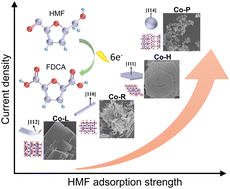
Green Chem., 2023,25, 8196-8206
https://doi.org/10.1039/D3GC02398B
Electrochemical synthesis of γ-keto sulfones containing a β-quaternary carbon center via 1,2-migration
An electrochemical method has been developed for the synthesis of γ-keto sulfones with a β-quaternary carbon center through 1,2-C migration mediated by sulfonyl under metal- and oxidant-free conditions.

Green Chem., 2023,25, 8273-8279
https://doi.org/10.1039/D3GC02128A
CO2 flow electrolysis – limiting impact of heat and gas evolution in the electrolyte gap on current density
This study investigates the effects of high current density CO2 electrolysis on the operation of GDE flow cells. It reports a new method of identifying windows of steady-state operation, complementing GDE optimization from a system-perspective.

Green Chem., 2023,25, 7794-7806
https://doi.org/10.1039/D3GC02140H
Stabilizing Cu0–Cu+ sites by Pb-doping for highly efficient CO2 electroreduction to C2 products
A Pb-doped Cu2O electrocatalyst is designed for highly efficient CO2 reduction to C2 products, which shows a C2+ FE of 83.9%. Pb can stabilize Cu+ and reduce the reaction energy barrier, thereby improving the catalytic performance.

Green Chem., 2023,25, 7635-7641
https://doi.org/10.1039/D3GC01506H
Efficient algal lipid extraction via a green bio-electro-Fenton process and its conversion into biofuel and bioelectricity with concurrent wastewater treatment in a photosynthetic microbial fuel cell
Algal biofuel production via a green bio-electro-Fenton process is a promising alternative to meet global energy demand.
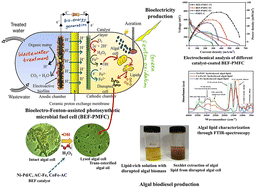
Green Chem., 2023,25, 7166-7182
https://doi.org/10.1039/D3GC01548C
A CoOxHy/β-NiOOH electrocatalyst for robust ammonia oxidation to nitrite and nitrate
In this work, we describe a composite electrocatalyst for the electrooxidation of ammonia to nitrite and nitrate under ambient conditions as a step towards stable, practical materials for this process.

Green Chem., 2023,25, 7157-7165
https://doi.org/10.1039/D3GC01835K
An efficient, green, and residual oxidant-free wastewater treatment technique enabled by coupling a dual-cathode heterogeneous electro-Fenton process and UV radiation in tandem
We present a green and robust wastewater treatment process that can eliminate the risk of oxidant residue while improving the decontamination efficiency by coupling dual-cathode heterogeneous electro-Fenton and UV radiation in tandem.

Green Chem., 2023,25, 6315-6326
https://doi.org/10.1039/D3GC01653F
Electrochemical transformation of D,L-glutamic acid into acrylonitrile
We present a new route for the electrochemical synthesis of green acrylonitrile using the biogenic amino acid D,L-glutamic acid as a substrate by utilising electro-oxidative decarboxylation and non-Kolbe electrolysis.

Green Chem., 2023,25, 6231-6237
https://doi.org/10.1039/D3GC01045G
Metal deposition and electrocatalysis for elucidating structural changes of gold electrodes during cathodic corrosion
This work provides deep insights into the structural changes likely to occur at cathodes under highly reducing conditions, such as HER, CO2, and N2 reduction, as well as cathodic electro-conversion in various (organic) electrosynthesis reactions.

Green Chem., 2023,25, 6238-6252
https://doi.org/10.1039/D3GC01614E
Electrosynthesis of N,N-dimethylformamide from market-surplus trimethylamine coupled with hydrogen production
We report an electrochemical oxidation strategy to synthesize DMF directly from market-surplus trimethylamine and couple it with hydrogen production. The reaction was achieved in an aqueous medium without any mediator using water as the oxidant.

Green Chem., 2023,25, 5936-5944
https://doi.org/10.1039/D3GC01406A
Defective nickel sulfide hierarchical structures for efficient electrochemical conversion of plastic waste to value-added chemicals and hydrogen fuel
Hierarchical defective nickel sulfide catalysts enable efficient electro-upcycling of plastic waste to value-added chemicals and hydrogen fuel.

Green Chem., 2023,25, 5979-5988
https://doi.org/10.1039/D3GC01499A
Electrocatalysis as an efficient alternative to thermal catalysis over PtRu bimetallic catalysts for hydrogenation of benzoic acid derivatives
PtRu bimetallic nanoclusters electrodeposited on carbon paper catalysts show highly efficient and uniquely selective electrocatalytic hydrogenation of aromatic rings in benzoic acid derivatives under mild and environmentally-friendly conditions.
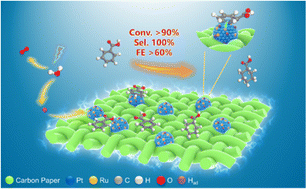
Green Chem., 2023,25, 5489-5500
https://doi.org/10.1039/D3GC01540H
Benzylic C–H arylation with dicyanoarenes via convergent paired electrolysis
We describe the convergent paired electrolysis of methylarene derivatives and 1,4-dicyanoarenes to perform the arylative functionalization of a benzylic C(sp3)–H bond to form 1,1-biarylmethane derivatives.

Green Chem., 2023,25, 5483-5488
https://doi.org/10.1039/D3GC00866E
A novel tandem reactor design based on nano-Cu electrocatalysts and microbial biocatalysts for converting CO2 into ethylene and acetate
An electron-bio tandem reactor is assembled with Cu catalysts and microorganisms. Ethylene is produced in the gas phase, and the byproducts such as HCOOH, CO, and H2 can be recycled as electron donors for acetate biosynthesis via the Wood–Ljungdahl pathway.

Green Chem., 2023,25, 5712-5720
https://doi.org/10.1039/D3GC01025B
Bipotentiostatic tandem electrocatalysis of the CO2 reduction reaction yielding C2+ fuels
In the Cu–Ag bipotentiostatic CO2RR, C2+ selectivity was improved to 67.3%, including a 6.5% efficiency towards 1-propanol. The system-controlled CO delivery allowed the determination of the C–C coupling turnover frequency of 0.43 ± 0.06 s−1.

Green Chem., 2023,25, 5290-5295
https://doi.org/10.1039/D3GC00974B
Investigating the electrocatalytic reduction of 2,4,6-tri-nitro-toluene (TNT) using density functional theory methods
TNT electro-reduction catalysts can be optimized by tuning O* affinity. A partially reduced Fe2O3 (0001) surface may deviate from late transition metal scaling behavior, expanding the design space for TNT reduction electrocatalysts.
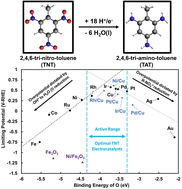
Green Chem., 2023,25, 5097-5112
https://doi.org/10.1039/D3GC01144E
Room-temperature fabrication of defective CoOxHy nanosheets with abundant oxygen vacancies and high porosity as efficient 5-hydroxymethylfurfural oxidation electrocatalysts
Defective cobalt oxide hydrate nanosheets with abundant oxygen vacancies and high porosity were fabricated via room-temperature reductive treatments, and they performed well in the electrocatalytic oxidation reaction of 5-hydroxymethylfurfural.

Green Chem., 2023,25, 4674-4684
https://doi.org/10.1039/D3GC00588G
Single-iron, cobalt, nickel, and copper-atom catalysts for the selective reduction of oxygen to H2O2
A series of single metal atom catalysts anchored into N-doped carbon nanosheets are evaluated for H2O2 electrosynthesis via oxygen reduction. The Cu/NCNSs exhibits the best catalytic performance in alkaline media with nearly 100% H2O2 selectivity.

Green Chem., 2023,25, 3931-3939
https://doi.org/10.1039/D3GC00737E
Pre-embedding an energetic metal–organic framework to create interconnected pore structures in nitrogen-doped carbon for green and effective hydrogen peroxide electrosynthesis
The two-electron (2e−) oxygen reduction reaction (ORR) is a green way to produce hydrogen peroxide (H2O2).

Green Chem., 2023,25, 4113-4121
https://doi.org/10.1039/D3GC00580A
Integrating electrocatalytic seawater splitting and biomass upgrading via bifunctional nickel cobalt phosphide nanorods
A hybrid electrolyser using NiCoP as a bifunctional electrode was constructed by coupling xylose oxidation with hydrogen evolution from seawater, aiming to boost the efficiency of seawater electrolysis.

Green Chem., 2023,25, 4104-4112
https://doi.org/10.1039/D3GC00684K
Versatile electrooxidative amino- and oxyselenation of alkenes
We herein describe a methodology for the production of organoselenium compounds by electrocatalytic difunctionalisation of alkenes.

Green Chem., 2023,25, 3925-3930
https://doi.org/10.1039/D3GC00837A
Electrochemical electrophilic bromination/spirocyclization of N-benzyl-acrylamides to brominated 2-azaspiro[4.5]decanes
An electrochemical electrophilic bromination/spirocyclization of N-benzyl-acrylamides to brominated 2-azaspiro[4.5]decanes with 2-bromoethan-1-ol as the brominating reagent has been developed.
![Graphical abstract: Electrochemical electrophilic bromination/spirocyclization of N-benzyl-acrylamides to brominated 2-azaspiro[4.5]decanes](/en/Image/Get?imageInfo.ImageType=GA&imageInfo.ImageIdentifier.ManuscriptID=D3GC00728F&imageInfo.ImageIdentifier.Year=2023)
Green Chem., 2023,25, 3543-3548
https://doi.org/10.1039/D3GC00728F
Exploring the electrochemical ring hydrogenation of furanic compounds
The utilization of Pd- and Pt-containing electrocatalysts for the ring-hydrogenation of furfural and related furans to tetrahydrofurans is investigated.

Green Chem., 2023,25, 3077-3085
https://doi.org/10.1039/D3GC00515A
RuS2@CN-x with exposed (200) facet as a high-performance photocatalyst for selective C–C bond cleavage of biomass coupling with H–O bond cleavage of water to co-produce chemicals and H2
RuS2@CN-x with exposed (200) facet as a high-performance photocatalyst for selective C–C bond cleavage of biomass coupling with H–O bond cleavage of water to co-produce chemicals and H2.

Green Chem., 2023,25, 3236-3246
https://doi.org/10.1039/D3GC00367A
Electrocatalytic amino acid synthesis from biomass-derivable keto acids over ball milled carbon nanotubes
Using ball milled CNT catalysts, the electrocatalytic reductive amination of keto acids to amino acids was efficiently conducted. Moderate to high formation rates (up to 180.9 mmol g−1cat h−1) and Faradaic efficiencies (up to 90%) were achieved.

Green Chem., 2023,25, 3117-3126
https://doi.org/10.1039/D3GC00265A
Extending the π-conjugation system of covalent organic frameworks for more efficient photocatalytic H2O2 production
Three highly crystalline and porous COFs with promising photoredox properties have been prepared. Via a post-sulfurization process, the imine-linked COFs were converted into thiazole-linked COFs, generating a highly conjugated and ultrastable photocatalyst for H2O2 production.

Green Chem., 2023,25, 3069-3076
https://doi.org/10.1039/D2GC04459E
Electrochemical conversion of lignin to short-chain carboxylic acids
A method for direct electrochemical conversion of lignin to short-chain carboxylic acids is developed.

Green Chem., 2023,25, 3127-3136
https://doi.org/10.1039/D3GC00324H
Ionic liquid-based electrolysis-deposition for modulating Pb crystal facets to boost CO2 electroreduction
The IL-based electrolysis-deposition method was used to modulate Pb crystal facets (ED-Pb) for enhancing the CO2RR. ED-Pb-900 shows a formate formation rate of 2067.2 μmol h−1 cm−2, due to the preferential exposure of Pb(111) and larger ECSA.

Green Chem., 2023,25, 2846-2852
https://doi.org/10.1039/D2GC04622A
Electrochemical dual α,β-C(sp3)–H functionalization of cyclic N-aryl amines
Herein, a straightforward route for dual α,β-C(sp3)–H functionalized cyclic N-aryl amines using a combination of electrocatalysis and iron catalysis is disclosed, setting the stage for the challenging multiple site selective C–H functionalization.

Green Chem., 2023,25, 2681-2689
https://doi.org/10.1039/D3GC00344B
A MOF-derived Co3O4/nitrogen-doped carbon composite for chlorine-assisted production of ethylene oxide
A MOF-derived cobalt oxide/nitrogen-doped carbon composite is prepared and it exhibits remarkable performance for chlorine-assisted ethylene oxide production.

Green Chem., 2023,25, 1982-1990
https://doi.org/10.1039/D2GC04508G
Tandem electrocatalytic aziridination – ring expansion of simple aromatic olefins using ammonia and carbon dioxide
The telescoped electrochemical coupling of NH3 and CO2 with simple aromatic olefins is described, forming valuable N-heterocycles in an atom-efficient manner with overall yields of up to 91%. The same iodide catalyst is required for both steps.

Green Chem., 2023,25, 978-985
https://doi.org/10.1039/D2GC03879J
Efficient photoelectrochemical Kolbe C–C coupling at BiVO4 electrodes under visible light irradiation
Under illumination with 450 nm light, porous BiVO4 photoelectrodes support photoeletrochemical Kolbe coupling with up to near quantitative faradaic efficiency and apparent quantum yield of 12% at applied voltages <2 V.

Green Chem., 2023,25, 1067-1077
https://doi.org/10.1039/D2GC04423D
Enhanced electroreduction of CO2 to ethanol via enriched intermediates at high CO2 pressures
The primary C2+ product of the CO2RR on the HS-Cu catalyst could be switched from gaseous ethylene to liquid ethanol by directly elevating the CO2 pressure with FEethanol as high as 36.6% at 100 bar CO2 pressure.

Green Chem., 2023,25, 684-691
https://doi.org/10.1039/D2GC03343G
Guiding research in electrochemical CO2 conversion strategies through a systems-level perspective
Life cycle assessment as a decision-making tool in R&D of CO2 conversion technologies. A set of technologies are explored to provide recommendations regarding potential climate impacts. Relevant fundamentals of this type of assessment are provided.
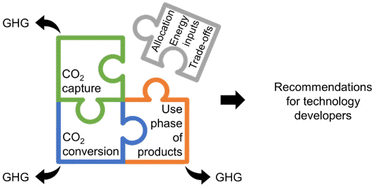
Green Chem., 2023,25, 229-244
https://doi.org/10.1039/D2GC01466A
About this collection
Guest Editors: Jean-Philippe Tessonnier (Iowa State University), Season Si Chen (Tsinghua University), Vassiliki-Alexandra (Vanda) Glezakou (Oak Ridge National Laboratory), Adam Holewinski (University of Colorado, Boulder) and Juan Lopez-Ruiz (Pacific Northwest National Laboratory).
Electrosynthesis is a fast-expanding field of research that is poised to play a critical role in the decarbonization of the chemical industry and the transition to green transformations for chemical production. This research area is less mature than traditional catalysis fields and innovations are typically scattered among multiple broad audience journals. Hence, this themed collection intends to bring this community together and share the latest original research, reviews, and perspectives on the electrosynthesis of chemicals and fuels.
This collection includes contributions on recent green advances in electrochemical transformations, including, but not limited to, hybrid processes that combine electrochemical with photo- or biocatalytic (microbial) transformations, catalyst development, electrolyzer cell designs, computational studies, and techno-economic analysis (with a focus on environmental concerns or life-cycle analysis).